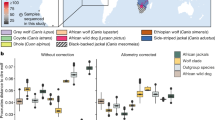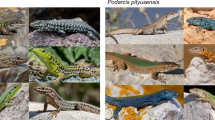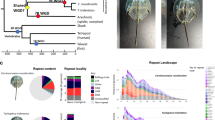Abstract
The origin of whales and their transition from terrestrial life to a fully aquatic existence has been studied in depth. Palaeontological1,2, morphological3 and molecular studies4,5,6,7 suggest that the order Cetacea (whales, dolphins and porpoises) is more closely related to the order Artiodactyla (even-toed ungulates, including cows, camels and pigs) than to other ungulate orders. The traditional view that the order Artiodactyla is monophyletic has been challenged by molecular analyses of variations in mitochondrial and nuclear DNA5,6,7. We have characterized two families of short interspersed elements (SINEs) that were present exclusively in the genomes of whales, ruminants and hippopotamuses, but not in those of camels and pigs. We made an extensive survey of retropositional events that might have occurred during the divergence of whales and even-toed ungulates. We have characterized nine retropositional events of a SINE unit, each of which provides phylogenetic resolution of the relationships among whales, ruminants, hippopotamuses and pigs. Our data provide evidence that whales, ruminants and hippopotamuses form a monophyletic group.
This is a preview of subscription content, access via your institution
Access options
Subscribe to this journal
Receive 51 print issues and online access
$199.00 per year
only $3.90 per issue
Buy this article
- Purchase on Springer Link
- Instant access to full article PDF
Prices may be subject to local taxes which are calculated during checkout




Similar content being viewed by others
References
Gingerich, P. D., Smith, B. H. & Simons, E. L. Hind limbs of Eocene Basilosaurus: evidence of feet in whales. Science 249, 154–157 (1990).
Thewissen, J. G. M. & Hussain, S. T. Origin of underwater hearing in whales. Nature 361, 444–445 (1993).
Novacek, M. J. Mammalian phylogeny: shaking the tree. Nature 356, 121–125 (1992).
Milinkovitch, M. C., Ortí, G. & Meyer, A. Revised phylogeny of whales suggested by mitochondrial ribosomal DNA sequences. Nature 361, 346–348 (1993).
Graur, D. & Higgins, D. G. Molecular evidence for the inclusion of cetaceans within the order Artiodactyla. Mol. Biol. Evol. 11, 357–364 (1994).
Irwin, D. M. & Arnason, U. Cytochrome b gene of marine mammals: Phylogeny and evolution. J. Mamm. Evol. 2, 37–55 (1994).
Gatesy, J., Hayashi, C., Cronin, M. A. & Arctander, P. Evidence from milk casein genes that cetaceans are close relatives of hippopotamid artiodactyls. Mol. Biol. Evol. 13, 954–963 (1996).
Weiner, A. M., Deininger, P. L. & Efstratiadiss, A. Nonviral retroposons: genes, pseudogenes, and transposable elements generated by the reverse flow of genetic information. Annu. Rev. Biochem. 55, 631–661 (1986).
Schmid, C. & Maraia, R. Transcriptional regulation and transpositional selection of active SINE sequences. Curr. Opin. Genet. Dev. 2, 874–882 (1992).
Okada, N. SINEs: Short interspersed repeated elements of the eukaryotic genome. Trends Ecol. Evol. 6, 358–361 (1991).
Okada, N. & Ohshima, K. in The Impact of Short Interspersed Elements (SINEs) on the Host Genome (ed. Maraia, R. J.) 61–79 (Landes, Austin, TX, 1995).
Murata, S., Takasaki, N., Saitoh, M. & Okada, N. Determination of the phylogenetic relationships among Pacific salmonids by using short interspersed elements (SINEs) as temporal landmarks of evolution. Proc. Natl Acad. Sci. USA 90, 6995–6999 (1993).
Murata, S., Takasaki, N., Saitoh, M., Tachida, H. & Okada, N. Details of retropositional genome dynamics that provide a rationale for a generic division: The distinct branching of all the Pacific salmon and trout (Oncorhynchus) from the Atlantic salmon and trout (Salmo). Genetics 142, 915–926 (1996).
Takahashi, H., Awata, T. & Yasue, H. Characterization of swine short interspersed repetitive sequences. Anim. Genet. 23, 443–448 (1992).
Lenstra, J. A., van Boxtel, J. A. F., Zwaagstra, K. A. & Schwerin, M. Short interspersed nuclear element (SINE) sequences of the Bovidae. Anim. Genet. 24, 33–39 (1993).
Gentry, A. W. n & Hooker, J. J. in The Phylogeny and Classification of the Tetrapods Vol. 2 Mammals (ed. Benton, M. J.) 235–272 (Clarendon, Oxford, 1988).
Adachi, J. & Hasegawa, M. Instability of quartet analyses of molecular sequence data by the maximum likelihood method: The Cetacea/Artiodactyla relationships. Mol. Phyl. Evol. 6, 72–76 (1996).
Hasegawa, M. & Adachi, J. Phylogenetic position of cetaceans relative to artiodactyls: Reanalysis of mitochondrial and nuclear sequences. Mol. Biol. Evol. 13, 710–717 (1996).
Philippe, H. & Douzery, E. The pitfalls of molecular phylogeny based on four species, as illustrated by the Cetacea/Artiodactyla relationships. J. Mamm. Evol. 2, 133–152 (1994).
Thewissen, J. G. M. Phylogenetic aspects of cetacean origins: a morphological perspective. J. Mamm. Evol. 2, 157–184 (1994).
Prothero, D. R., Manning, E. M. & Fischer, M. in The Phylogeny and Classification of the Tetrapods Vol. 2 Mammals (ed. Benton, M. J.) 201–234 (Clarendon, Oxford, 1988).
Fordyce, R. E. & Barnes, L. G. The evolutionary history of whales and dolphins. Annu. Rev. Earth Planet. Sci. 22, 419–455 (1994).
Rose, K. D. Skeleton of Diacodexis, oldest known artiodactyl. Science 216, 621–623 (1982).
Golz, D. J. Eocene Artiodactyla of southern California. Nat. Hist. Mus. Los Angeles County, Sci. Bull. 26, 1–85 (1976).
Hedges, S. B., Parker, P. H., Sibley, C. G. & Kumar, S. Continental breakup and the ordinal diversification of birds and mammals. Nature 381, 226–229 (1996).
Acknowledgements
We thank the Zoological Society of San Diego's Center and Y. Mukai in the Meat Hygenic Inspection Office in Ueda, Nagano prefecture for providing a sample of DNA from the lesser Malayan chevrotain and samples of DNA from calf, pig and sheep, respectively. This work was supported by a Grant-in-Aid for Specially Promoted Research from the Ministry of Education, Science, Sports and Culture of Japan.
Author information
Authors and Affiliations
Corresponding author
Rights and permissions
About this article
Cite this article
Shimamura, M., Yasue, H., Ohshima, K. et al. Molecular evidence from retroposons that whales form a clade within even-toed ungulates. Nature 388, 666–670 (1997). https://doi.org/10.1038/41759
Received:
Accepted:
Issue Date:
DOI: https://doi.org/10.1038/41759
This article is cited by
-
Elucidate Genetic Diversity and Population Structure of Bread Wheat (Triticum Aestivum L.) Cultivars Using IRAP and REMAP Markers
Journal of Crop Science and Biotechnology (2019)
-
Linkage disequilibrium and functional analysis of PRE1 insertion together with SNPs in the promoter region of IGFBP7 gene in different pig breeds
Journal of Applied Genetics (2018)
-
Resolving kangaroo phylogeny and overcoming retrotransposon ascertainment bias
Scientific Reports (2017)
Comments
By submitting a comment you agree to abide by our Terms and Community Guidelines. If you find something abusive or that does not comply with our terms or guidelines please flag it as inappropriate.



